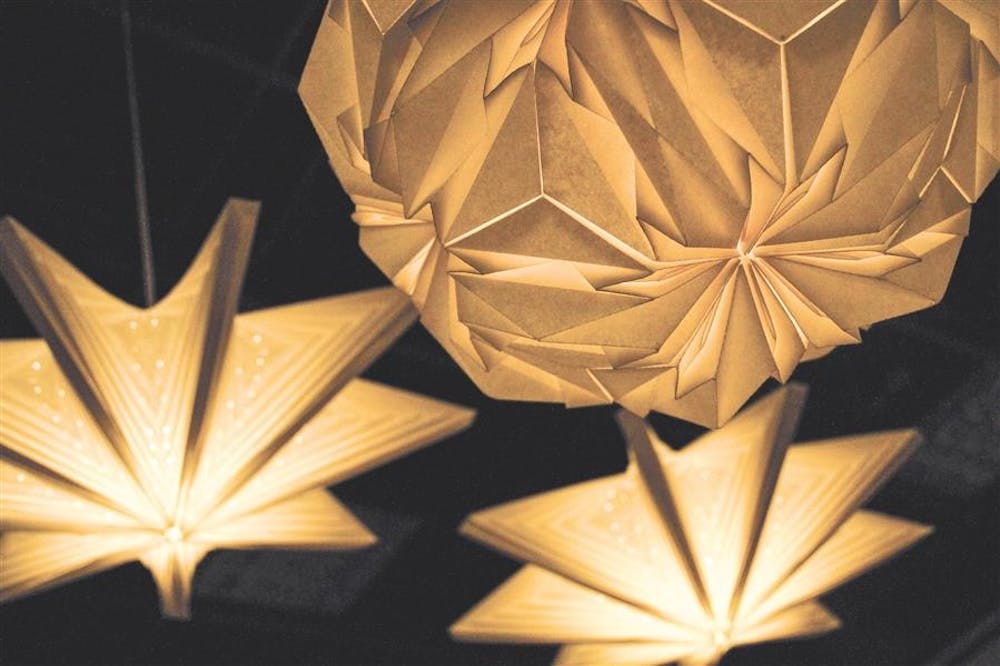Jiangmei Wu is an IU professor of apparel merchandising and interior design. But when she’s not teaching, she’s designing intricate, artistic light fixtures. The IDS had the chance to speak with Wu about her artistic inspiration and her folded light art exhibit, currently on display at the Ivy Tech John Waldron Arts Center.
IDS What impact do you feel that your work has here at IU?
Wu I often tell my students that career path for design has become broader in recent years. Design can be applied to a wide range of services in our society, from business development to strategic planning. The key here is design thinking, which emphasizes on the process rather than the product. I look at my work as a process to understand the meaning of my work in relationship to the outside world.
IDS How do you integrate Chinese influences into your work?
Wu I grew up in China during the time when resources were extremely scarce. Most of the Chinese children at that time didn’t have toys — we played with simple things we made with our hands. We played games with shuttlecocks made of feathers and bottle caps, slingshots made of rubber bands and wooden sticks and of course, airplanes and balloons made of paper. Indeed, we made all sorts of objects from paper: balls, baskets, dollhouses, bird figurines and other objects. Paper was a common commodity, but it was not abundant and cheap during that time. We would fold and make objects using all kinds of paper from old newspapers, old magazines and used notebooks.
When I was a child, I learned many of origami models from my mother instead of from books. When my son was younger, he and I used to fold a lot together. For us, folding is almost a Zen-like activity and its kind of therapeutic — your hands are busy, but your mind is focusing on the moments that are taken over by the wonders transformed by your hands.
IDS Are you working on any pieces right now that you’re really excited about?
Wu I would like to experiment with 3D printing technology. By using the origami techniques, an object potentially can be printed small and folded using a 3D printer and then be deployed into a three dimensional object that is larger. I would also like to experiment with ways to change the properties of large scale structures, not using a clever new material, but using a standard material with folded texturing on its surface, such as paper, sheet metal, polypropylene or any other foldable materials.
IDS What advice would you give to someone who wants to work in the same artistic context?
Wu It is a very exciting new field that allows one to work in increasingly ambiguous space between art, design, engineering and science. In most recent years, scientists are beginning to use the analogies of the origami crease patterns to analyze and classify natural phenomenon, from the folding and self-assembly of amino acids, the unfurling of new leaves, to the tessellated formation of cosmic structures by the force of gravity. For some scientists, the universe, at both the macroscopic and microscopic scales, ‘folds’ rather than ‘builds.’
There is also a wide range of origami applications in both engineering and design. For example, engineers are using the art of paper folding to understand how to manufacture the nanostructured materials that can be used for flexible electronic devices, etc. On the opposite scale of nanostructures, they are also working on foldability of large solar-powered structures. Designers have applied origami principles to various design disciplines such as jewelry design, product design, architectural and interior design, and have created origami inspired objects, not necessarily in paper. Perhaps the most well-known designer is Issey Miyake, who designed fashion and lighting that can be folded flat and be deployed into three dimensional objects.
IDS What is your favorite part of the artistic process?
Wu The dramatic transformation of the paper after it is folded. I often began with the systematic exploration of folding schemes, but I was soon taken over by the magic transformation which was beyond I could visualize at the beginning of the process. In this way, I finished my work in wonder, in curiosity and in awe of the power of mysterious creative force.
Follow reporter Alexis Benveniste on Twitter @apbenven.
Wu discusses her folded sculptures

Get stories like this in your inbox
Subscribe





